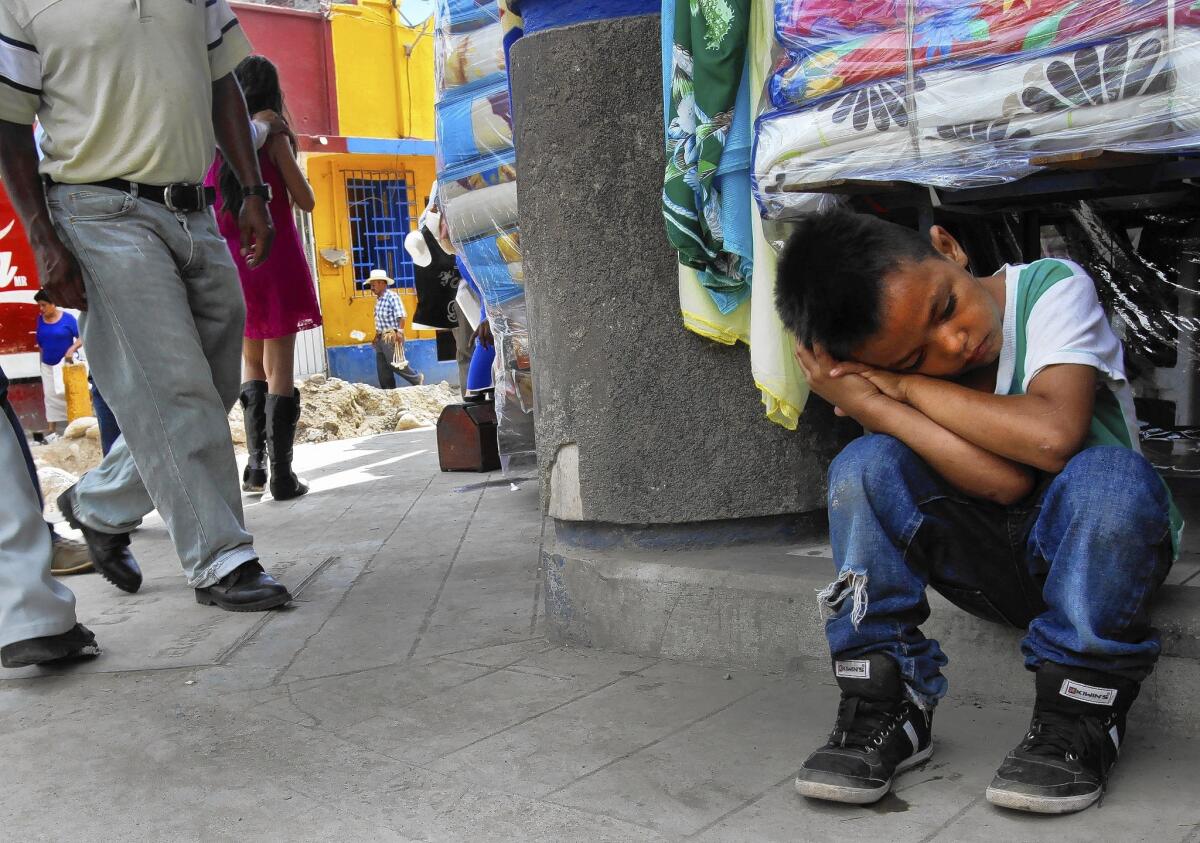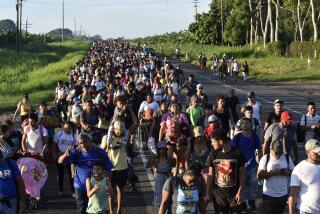Exploitation awaits migrant children on Mexico’s southern edge

- Share via
Reporting from Tapachula, Mexcio — They are called canguritos, little kangaroos, because of the plastic trays of candy, cigarettes and other goods strapped across their bellies.
There is Juan Gonzalez, 10, selling gum for pennies. There are Humberto Vazquez, 11, and Wilmer Hernandez, 13, shining shoes.
And a few dark-skinned girls, none taller than 4 feet nor older than 12, wrapped in colorful indigenous cloth as skirts and offering tired pastries.
The northward passage of Central American children, many without their parents, is a familiar sight along Mexico’s southern border with Guatemala. Though the exodus has been dominating U.S. headlines of late, tens of thousands of youngsters have waded the Suchiate River or floated across it on inner-tube rafts annually for many years.
Some are stranded here, unable to afford to go farther — and vulnerable to abuse. Others aren’t even trying to reach the United States. Their hometowns are racked by such violence and poverty that a city as scruffy as Tapachula, on Mexico’s southernmost tip, is better than where they were.
Little has been done to address what diplomats, activists and the migrants themselves say is a central problem: the complicity of police and other local officials who prey on those fleeing Central America, demanding bribes or sexual favors.
“There is a spectacular vulnerability,” said Diego Lorente, director of the Friar Matias de Cordova Human Rights Center in Tapachula.
“Without a network of corruption of the authorities,” he said, “it would be impossible to have undocumented foreign children [working or begging] on major street corners. How else could it function?”
::
Humberto has been in Tapachula since leaving Huehuetenango, Guatemala, four years ago. He lives with an uncle and rarely attends school
“It’s a lot of work, but I can make more here,” he said.
What has changed this year is that the number of children traveling without a parent has soared, the children are younger than ever and more are girls. According to a new study by the Pew Research Center, the number of minors age 12 and younger has grown 117% compared with 2013, while the number of girls younger than 18 caught at the U.S. border was up 77% this year through May. That compares with an 8% increase for males.
The Mexican government, under U.S. pressure, recently sought to make a show of restricting immigration. Most of the actions the government has trumpeted, however, are a repeat of measures announced a year ago, and largely ineffective, critics say.
They include temporary work permits for some Central Americans, but only for use in southern border states; nominal improvements to “La Bestia,” the precarious freight trains used by migrants to traverse Mexico; and, more quietly, stepped-up deportation.
But Lorente pointed to what he said were well-organized networks that traffic minors to Tapachula and beyond, often from the same handful of Honduran or Guatemalan towns. They are influential and powerful gangs, Lorente said. “To touch them is very dangerous.”
Once the purview of the notorious Zeta cartel and paramilitary force, the deadly trade has increasingly been taken over by gangsters from the same Central American countries as their victims, with the compliance of police or immigration authorities, migrants and activists say.
Last year, 11 police officers were dismissed after reports that they were charging Central American children fees to work the streets. But the officers were not prosecuted.
Ramon Verdugo, who runs a shelter for migrant children in Tapachula and who has received death threats for his efforts, said the practice is rampant; police or other local officials demand weekly quotas equivalent to about $20 from youngsters who work as prostitutes, he said.
“They are exploited time and again, first by the smugglers, then by the government,” Verdugo said.
::
Verdugo was installing surveillance cameras and an alarm system at his shelter the other day, after veiled threats of violence, probably from those powerful gangs.
Three children — brothers Anderson and Jefferson Daniel, 7 and 10, and Anthony Fabricio, 5, all from the violent Honduran city of San Pedro Sula — watched a one-legged man, Jose Vazquez, who was lying listlessly on a bunk bed. Like many, Vazquez lost a limb in an accident on La Bestia.
“My family couldn’t afford school for me, so here I am,” said Michael Morales, 13, from Concepcion, Honduras. He had been in Tapachula for three months, and was living with “uncles.” He earns the equivalent of about $11 a month selling gum and lollipops.
At another shelter in Tapachula, run by the Roman Catholic Church, a group of men studied a map of Mexico and with their calloused fingers traced the train routes. Posted on the map were distances.
Tapachula to New York: 2,718 miles
Tapachula to Los Angeles: 2,501 miles
Tapachula to Chicago: 2,285 miles
The shelter also cautioned about the danger to anyone, adult or child, of the route north.
The walls were plastered with numerous warnings and mug shots of suspected coyotes, or guides: “Brother migrant, don’t trust people who arrive here and offer to accompany you.... There are gangs waiting to take the little you have, and you run the risk of death.”
In Arriaga, about three hours north of Tapachula, more women and children waited in a shelter. Zoila Vazquez of La Ceiba in northern Honduras, was stirring a vat of bean soup. Two months ago, she grabbed her 10-year-old son, Oscar — her youngest child and only male in a brood of daughters — and headed north.
Family in Los Angeles had told her that it was the time to go, that she could probably enter the U.S. and would be allowed to stay.
But she and her son, waiting in southern Mexico for the freight train, were kidnapped by heavily tattooed gangsters from, she believes, El Salvador. They held them for several days, demanding payment. She had no money.
“I prayed and prayed and prayed and knew only God could save me,” Vazquez said.
Only the sudden derailment of the train, which scattered people gathered trackside, allowed Vazquez and Oscar to escape. They reported the crime to Mexican authorities and are now hoping for papers that will allow them to travel across Mexico legitimately by bus.
The window that Vazquez thought had opened at the U.S. border, however, has closed. Her relatives are telling her not to turn herself in to U.S. immigration authorities as originally planned but to go the old-fashioned way, hooking up with a coyote and crossing illegally.
“It is too hard at home,” she said of the remote, Caribbean La Ceiba region, now a prime transit point for cocaine from South America.
“There are narcos everywhere, the factories are closing, gangs ransack homes, no more tourists come,” Vazquez said. She lost her job ironing shirts at a maquiladora when it shut down amid security problems.
It has taken Ingrid Palacio Vasquez four months to get this far from her home in Progreso, Honduras, with her children Alesandra, 5, and Kevin, 2. They left because gangs were stealing their possessions, trying to seize their home and demanding they get tattoos and join the ranks.
“They threatened to kill the children,” Palacio said. “We hope to have better luck now. I don’t know what will happen. But you lose nothing trying.”
More to Read
Sign up for Essential California
The most important California stories and recommendations in your inbox every morning.
You may occasionally receive promotional content from the Los Angeles Times.











